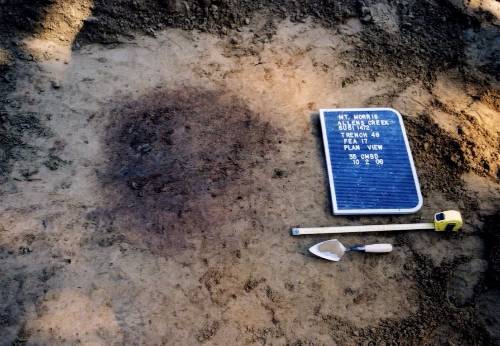Features and Subsistence Remains
Archaeologists identified 26 features at the Allen's Creek site. Features were encountered in two main contexts: at the transition of the fill and B2 horizons (features that presumably originated within upper A horizon soils) and features contained within the B2 horizon. Features encountered at the fill/B2 horizon transition include 5 hearths, 11 smudge pits, and 1 small basin. A total of eight features originated within the B2 horizon: 3 hearths, 4 smudge pits, and 1 small basin. A single hearth feature, Feature 1, was identified within a deeply buried A horizon (A3) beneath the B2 horizon.

Hearth features are common on many precontact sites and represent open fires used
for cooking, resource processing, heating, and light. Smudge pits functioned in the
preparation of hides. These pits are small with densely charred plant materials. The
goal of a smudge pit is to produce a smokey, smoldering, flame-free fire suitable
for smoking hides without high flames that could damage them. The two small basins
are characterized by soils lightly flecked with charcoal, containing small amounts
of calcined bone and shell. The function of these pits is unknown.

Subsistence remains include both faunal and floral remains. Five features at the site
produced a total of 64 faunal remains. Researchers classified all of the remains as
medium/large mammal bones that could not be attributed to a specific species. It is
most likely that these bone fragments represent the remains of game animals (possibly
white-tailed deer). The recovery of numerous projectile points and possible smudge
pits at the site also suggest that the hunting and processing of game animals was
a major site activity.
Archaeologists identified botanical remains from 12 Allen's Creek features. Every feature analyzed contained nutshell, mainly hickory, but also possibly acorn and, to a lesser degree, walnut. Most features contained more than one type of nutshell. Nuts provide food, oils, fuel, and, in the case of walnuts, dyes. The abundance of nutshell, the presence of various types of nutshell, and the presence of more than one type in a single feature indicates that nutmeat was used for food. The nutshells could have been burned to produce smoke for processing hides. Two features contained charred grass seeds which could have been part of a lining or, since the seeds were in smudge pits, the seeds could represent plants burned to produce the necessary smoke for preparing hides. Very few seeds were identified at the site. These include Brassenia scherabii, a water plant; possible Chenopodium sp.; Viburnum sp.; and Vitis sp., wild grape. Viburnum sp. can be used as a uterine tonic and an antispasmodic. Vitis sp. was used for food and the vines for baskets.